Content
Bamberger onions are a popular mid-late variety in Europe. It attracts consumers with its unique shape, stable yield and other advantages. The variety is not included in the State Register of the Russian Federation, but it is successfully grown in many Russian regions. You can plant a culture in different ways, it is unpretentious in care.
Origin story
Bamberger onions were formerly known under a different name - Birnformige. The translation of the word means "pear-shaped". The variety is of Dutch origin and bred by Triumfus Onion Products. The company has been specializing in the cultivation and processing of onions for many years, exporting its products to dozens of countries.
Description of the Bamberger onion variety
The Bamberger variety is distinguished by its oval-shaped bulbs. The narrowing towards the base and neck is smooth. In length, the bulbs do not exceed 10 cm, weigh on average 70-80 g. They have a strong light brown husk, it is easy to peel it.
The Bamberger variety has white and juicy flesh of moderate pungency. Its taste is slightly sweet.
The cultivation of Bamberger provides not only onions, but also feathers. The greenery reaches a height of 40-50 cm.
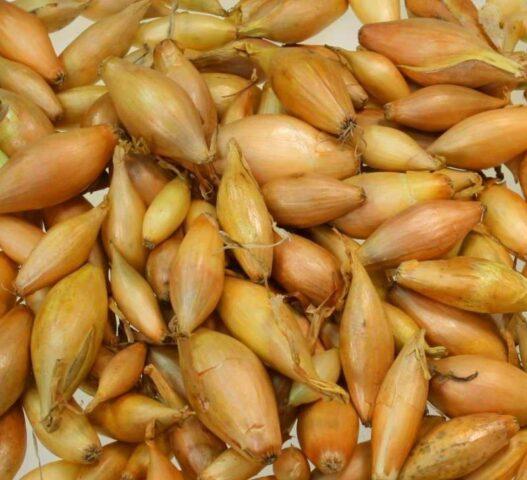
Bamberger can be planted in late April or early May, the variety is not afraid of the cold, loves moisture-saturated soil
Characteristics of the variety
The neck of Bamberger bulbs is of medium fineness. This property allows long-term storage. The crop can lie until spring without much loss.
Ripening time and yield
Bamberger onions are medium late varieties. It takes 90-100 days to reach technical ripeness. The duration of this period depends on the climatic characteristics of the region. In some areas, it can take up to 130 days.
The Bamberger variety has a high yield. On average, 7-8 kg of onions are harvested from 1 m².
Disease and pest resistance
Bamberger onions have good immunity. The cultivar is resistant to the main characteristic diseases of the crop, but can suffer from onion fly larvae.
Composition and properties
The composition of Bamberger onions includes ascorbic acid and B vitamins. There are many other valuable elements in it:
- minerals - cobalt, silicon, copper, phosphorus, potassium, zinc, manganese, iron;
- Sahara;
- amino acids;
- Omega-3 and 6;
- phytoncides;
- flavonoids;
- saponins.
The most useful raw Bamberger onion. The product has many useful properties:
- antibacterial action;
- toning the body;
- increased immunity;
- antiviral effect;
- prevention of diseases of the oral cavity;
- acceleration of metabolism;
- anthelmintic property;
- stimulation of natural insulin production;
- lowering blood glucose levels;
- increased potency.
You need to eat onions in moderation - irritation of the gastric mucosa is fraught with nausea, heartburn. In some diseases of the gastrointestinal tract, the product is prohibited completely or only in its raw form.
Application
Bamberger is versatile in use. Due to its sweetish taste and moderate pungency, onions of this variety are good fresh.Its elongated shape is ideal for slicing into rings, which is used in the preparation of salads and snacks.
Bamberger onions are recommended for canning, pickling. The variety is also suitable for heat treatment, especially roasting.
Advantages and disadvantages
Gardeners appreciate the taste of the Bamberger onion and its unique shape. The variety owes its popularity largely to its resistance to shooting.
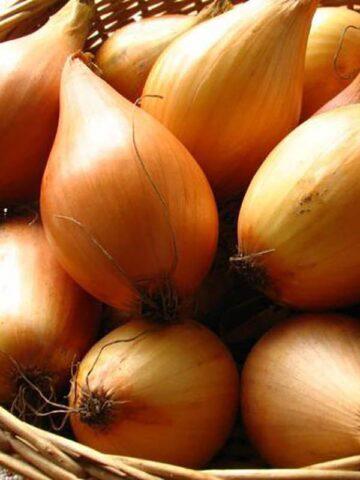
Bamberger onions are not prone to sprouting when stored for a long time
Pros:
- elongated shape;
- good productivity;
- adaptation to different weather conditions;
- juicy pulp;
- ease of separation of the husk;
- long-term storage;
- immunity to most diseases;
- the possibility of landing in different ways.
Minuses:
- susceptibility to onion fly larvae;
- exactingness to soil fertility.
Planting methods for Bamberger onions
Bamberger onions can be planted by seeds or sets in open ground, grown through seedlings. The culture feels good after legumes, cucumbers, tomatoes, cabbage. The variety prefers sandy loam or light loam, picky about soil fertility.
Growing seedlings from seeds
Growing Bamberger through seedlings allows you to get onions in one year. The process begins with the preparation of seeds:
- Dip the nigella in a solution of potassium permanganate for 40 minutes.
- Rinse the seeds, dry.
- Warm up nigella for 20 minutes in hot water (temperature up to 50 ° C).
- Immerse the seed in cold water for a minute.
- Treat the seeds with Epin or another growth stimulant, following the instructions for the preparation.
For sowing nigella, purchased soil or a mixture of equal parts of sod land and humus is suitable. For better looseness, add vermiculite or coconut fiber.
Bamberger seeds can be grown in wooden crates, pots or opaque containers. The seeding algorithm is simple:
- Fill containers with soil with a layer of 8 cm.
- Moisten the earth in a day.
- Make holes or grooves 1 cm deep, leave 3 cm between the rows.
- Sow seeds at 2 cm intervals.
- Sprinkle soil over the plantings.
- Compact the ground slightly.
- Moisten the soil with a spray bottle.
- Make a glass or film shelter.
Until emergence, the seedlings are kept warm (optimally 25 ° C). Then the shelter is removed, good lighting is provided. Seedlings can be kept on the windowsill, in the greenhouse. Caring for her consists in the following activities:
- regular watering - maintain moderate humidity, use warm water;
- thinning - leave 2 cm between adjacent shoots;
- fertilization seven days after sowing, then two weeks later;
- pruning when two leaves appear by 1-2 cm to stimulate the development of the root system.
You can feed Bamberger onion seedlings with a solution of chicken manure (1:10) or the following composition:
- a bucket of water;
- 5 g of potassium chloride;
- 10 g of urea;
- 20 g superphosphate.
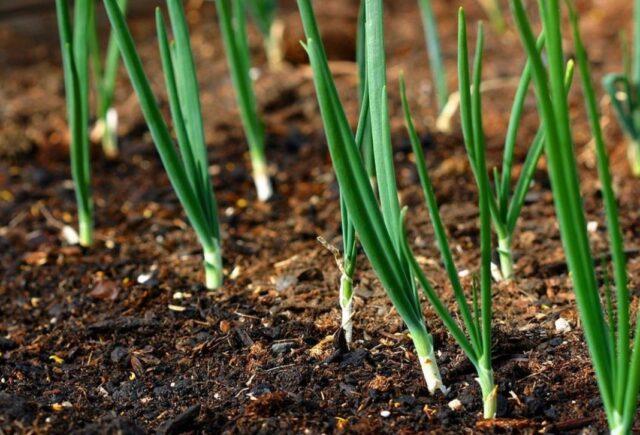
Sowing Bamberger seeds for seedlings should be about 50 days before moving to open ground
In the open ground, the seedlings are moved in the evening or on cloudy days after preliminary watering. The leaves are cut off by a third, the roots are shortened to 2.5 cm, processing with a talker made of clay and humus.
Planting seedlings in the spring in open ground
For planting, you can use your own or purchased Bamberger sevok. Be sure to dry the raw materials to prevent spoilage. For 2-3 weeks before planting, it is kept in a warm place at 20 ° C, then a day at 35-40 ° C. Another option for heating is to lower the bulbs in hot water for 20 minutes, treat with a growth stimulant.
The Bamberger variety has good immunity, but it is better not to neglect prevention and process the set in a solution of potassium permanganate.Copper sulfate is also effective for disinfection.
The site for planting sevka is prepared in the fall:
- digging;
- elimination of weeds;
- burning plant residues;
- introduction of organic matter, but not fresh manure.
For spring planting, take a Bamberger set no smaller than 1 cm.Order of work:
- Dig up the site, loosen it up.
- Make holes, leave 20-30 cm between the rows.
- Plant the sevok.
- Mulch the garden bed. You can use hay, straw, sawdust.
- If desired, lay a covering material to speed up germination.
When planting seedlings, you can leave 10 cm between adjacent bulbs. This distance will increase due to the collection of greenery.
Is it possible and how to plant Bamberger onions before winter
It is permissible to plant Bamberger before winter. This should be done in late autumn, before persistent cold weather sets in. There must be at least two weeks before frost for the culture to take root. Landing Algorithm:
- Dig up the area in advance, add 5 kg of humus, 10 g of potassium sulfate, 20 g of superphosphate per 1 m².
- Add 10 g of wood ash per m² before planting.
- Remove weeds, level the area, compact the surface.
- Make grooves at a distance of 20 cm.
- Spread dry seedlings over the grooves at intervals of 6 cm.
- Cover the planting with soil, do not moisten.
- When frost occurs, mulch the garden bed. You can use dry foliage, spruce branches, coniferous litter. Cover the mulch with branches.
It is optimal to deepen the sevok by 5 cm. Before planting, it is sorted out. Bulbs from 3 cm in diameter are good for greens; smaller specimens are used for turnip.
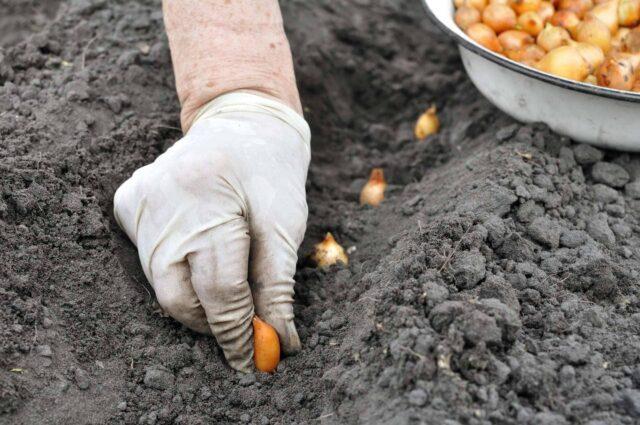
When planted in autumn, Bamberger will absorb moisture during the winter, becoming even juicier and tastier.
Bamberger onion care
The Bamberger bow is unpretentious in leaving. Culture needs standard activities:
- watering - plentiful during the first half of the growing season, then it is important to reduce it, stop a few weeks before harvesting;
- regular weeding;
- systematic loosening;
- fertilizing three times.
Feeding the Bamberger varnish begins two weeks after planting, using a solution of chicken manure. A month later, nitrogen and minerals are added, after another four weeks potash fertilizers.
With the right care and preparation for planting, growing Bamberger onions is hassle-free. The crop can be affected by onion fly larvae.
There are several methods of struggle:
- insecticide preparations - Actellik, Aktara, Calypso, Engio;
- folk remedies - tobacco dust, a decoction of needles, mint, valerian, a solution of ammonia, salt;
- repellent plants - carrots, tomatoes, mint.
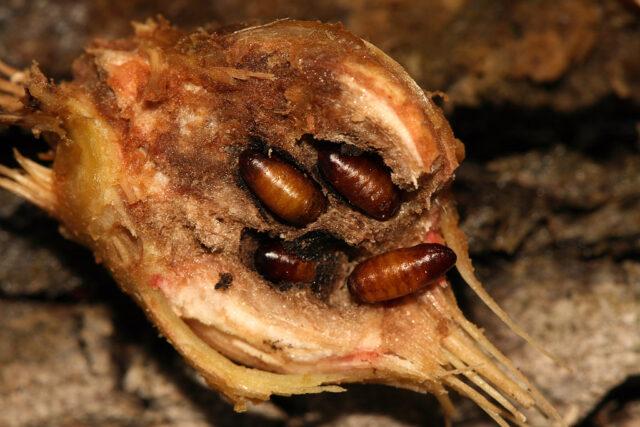
The defeat of an onion fly leads to the death of plants, rotting of bulbs, the appearance of a fungus
Conclusion
Bamberger onions have a sweetish, moderately pungent taste, are versatile in use, suitable for long-term storage. You can plant the variety with seeds or sets, in spring and before winter. In care, Bamberger is unpretentious, resistant to diseases and most pests.
Reviews of gardeners about onion Bamberger








